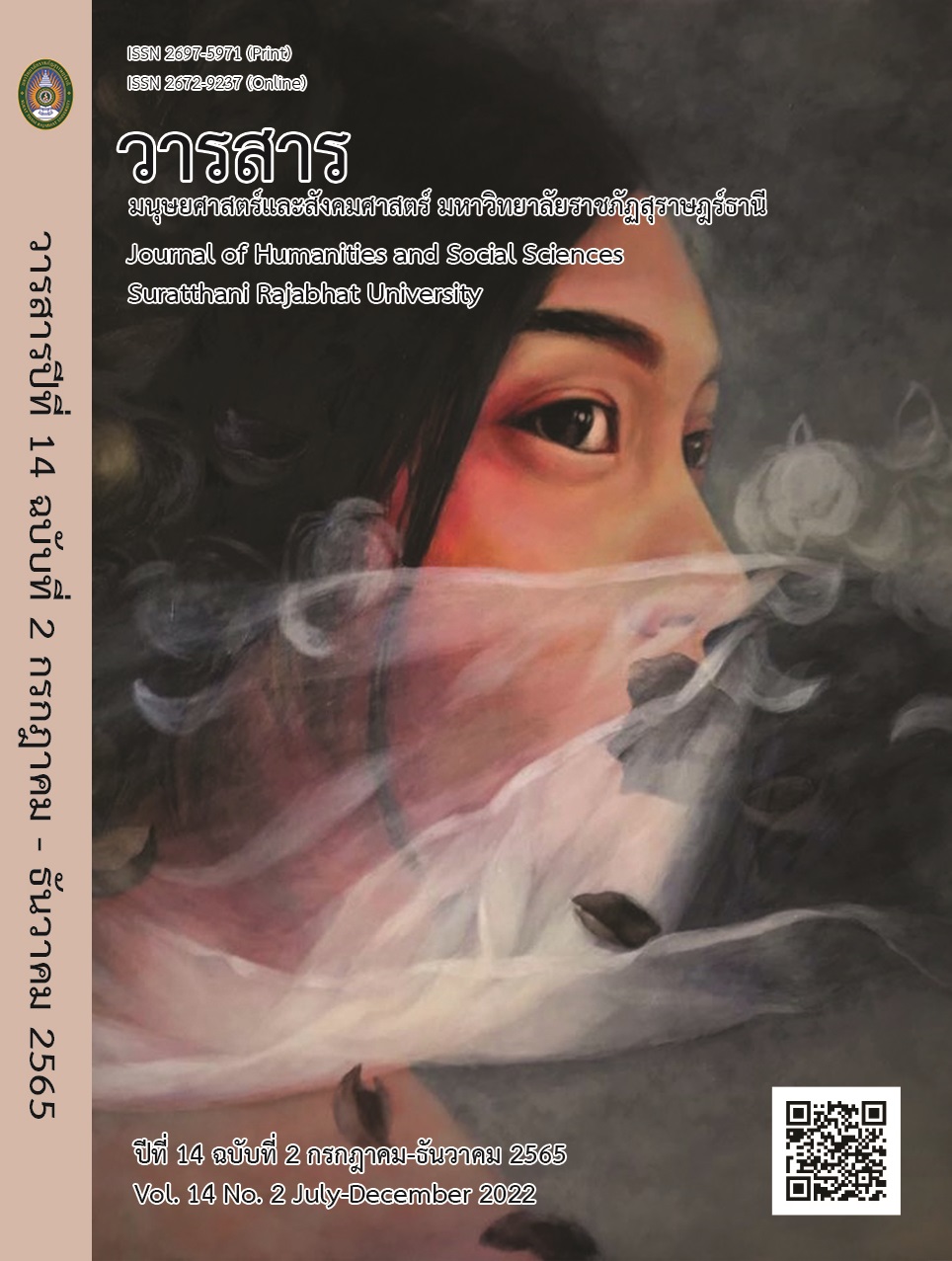Research on “Romance of the Three Kingdoms” in the Thai Academic Database during the Period of 1966-2018
Main Article Content
Abstract
This study was documentary research that employed thequalitative synthesis method. The aims of the study were to 1) survey the current situation and tendency of research on the Romance of the Three Kingdoms in the ThaiJo and TDC databases, including quantitative data on the number of documents and study fields, and qualitative data on the significance of the study's findings, and 2) look into how the Romance of the Three Kingdoms has influenced Thais' explicit knowledge construction. First, the findings showed that 55 documents from 9 fields of study existed for quantitative data from 1966 to 2018. Also, the number of publications and academic fields using the Romance of the Three Kingdoms as research
papers is continually increasing, especially since 1977, when Thailand and the People's Republic of China established diplomatic relations. The majority of research, according to qualitative findings, was in the areas of politics, military science, literature, and linguistics. Second, it was found that, for the most part, the Romance of the Three Kingdoms served as the primary source of explicit knowledge about the languages, literature, cultures, and histories of Thailand and China, followed by the source of practical knowledge in organizational, political, military, and personal attributes, as well as leadership development. However, it was noteworthy to remark that most knowledge from both perspectives is primarily focused on understanding Thainess or adapting it to suit Thai people, rather than being explicitly used to learn about China.
Article Details

This work is licensed under a Creative Commons Attribution-NonCommercial-NoDerivatives 4.0 International License.
All published manuscripts have been verified by peer-peer professors in the fields of humanities and social sciences. Reprinting of the article must be authorized by the editorial staff.
References
โครงการพัฒนาเครือข่ายระบบห้องสมุดในประเทศไทย. (2562). ฐานข้อมูล ThaiLIS Digital
Collection. https://tdc.thailis.or.th/tdc/index.php
ดำรงราชานุภาพ, สมเด็จพระเจ้าบรมวงศ์เธอ กรมพระยา. (253?). ตำนานหนังสือสามก๊ก.
กรุงเทพฯ: ดอกหญ้า.
ทัศน์ธนิต ทองแดง. (2564). ความหลากหลายของจำนวนสาขาวิชารายทศวรรษ. ใน
รายงานวิจัยวรรณกรรมสามก๊กที่เผยแพร่ในฐานข้อมูลวิชาการไทย ระหว่าง
พ.ศ. 2509-2561. ปัตตานี: มหาวิทยาลัยสงขลานครินทร์ วิทยาเขตปัตตานี.
ทัศน์ธนิต ทองแดง. (2564). จำนวนเอกสารรายทศวรรษ. ใน รายงานวิจัยวรรณกรรมสาม
ก๊กที่เผยแพร่ในฐานข้อมูลวิชาการไทย ระหว่าง พ.ศ. 2509-2561. ปัตตานี:
มหาวิทยาลัยสงขลานครินทร์ วิทยาเขตปัตตานี.
ทัศน์ธนิต ทองแดง. (2564). แผนภูมิแสดงร้อยละองค์ความรู้จากวรรณกรรมสามก๊ก. ใน
รายงานวิจัยวรรณกรรมสามก๊กที่เผยแพร่ในฐานข้อมูลวิชาการไทย ระหว่าง
พ.ศ. 2509-2561. ปัตตานี: มหาวิทยาลัยสงขลานครินทร์ วิทยาเขตปัตตานี.
ทัศน์ธนิต ทองแดง. (2564). QR Code แสดงข้อมูลแสดงจำนวน ชื่อเรื่อง ประเภทเอกสาร
ของการศึกษาวรรณกรรมสามก๊ก. ใน รายงานวิจัยวรรณกรรมสามก๊กที่เผยแพร่
ในฐานข้อมูลวิชาการไทย ระหว่าง พ.ศ. 2509-2561. ปัตตานี: มหาวิทยาลัย
สงขลานครินทร์ วิทยาเขตปัตตานี.
นงลักษณ์ วิรัชชัย. (2542). การวิเคราะห์อภิมาน. กรุงเทพฯ: จุฬาลงกรณ์มหาวิทยาลัย.
บุญศักดิ์ แสงระวี. (2563). หลอก้วนจง ผู้ให้กำเนิดสามก๊ก. กรุงเทพฯ: แสงดาว.
ยศไกร ส.ตันสกุล. (2557). จากวรรณกรรมคลาสสิกสู่หนังสือขายดี: การผลิตสามก๊กให้
เป็นสินค้าหลังปี 2540. วารสารจีนศึกษา, 7(1), 15-43. https://so01.tci-
thaijo.org/index.php/CSJ/article/view/55000
ระบบฐานข้อมูลวารสารอิเล็กทรอนิกส์กลางของประเทศไทย. (2562). Thai Journals.
สุนันท์ พวงพุ่ม. (2528). การศึกษาสารของผู้ประพันธ์สามก๊กฉบับต่าง ๆ ในภาษาไทย
[วิทยานิพนธ์ปริญญามหาบัณฑิต, มหาวิทยาลัยศิลปากร]. ThaiLIS. https://
tdc.thailis.or.th/tdc/index.php
สุพัฒน์ สุกมลสันต์. (2535). การอภิวิเคราะห์และการสังเคราะห์งานวิจัยที่เกี่ยวข้องกับการ
เรียนการสอนภาษาอังกฤษในระหว่างปี พ.ศ. 2515-2530. กรุงเทพฯ:
จุฬาลงกรณ์มหาวิทยาลัย.
อุทุมพร จามรมาน. (2531). การสังเคราะห์งานวิจัย: เชิงปริมาณ เน้นวิธีวิเคราะห์เมตต้า.
กรุงเทพฯ: ฟันนี่พับบลิชชิ่ง.
Amornwanitsak, S. (2007). The dissemination and influences of Chinese
classical novels in Thailand [doctoral dissertation, Zhejiang University].
CNKI. https://cnki.net/
Luxun. (2019). Zhongguo xiaoshuo shilue. Shanghai: Shanghai Guji.
Song, Z.J. (2020, December 5). Chutan Zhongguo dui Taiyi “Sanguo” yanjiu de xianzhuang.
Today’s Massmedia, 2020(12), 77-80. https://kns.cnki.net/kcms/
detail/detail.aspx?dbcode=CJFD&dbname=CJFDLAST2021&filename=
BKZY202012022&uniplatform=NZKPT&v=rnyFC6QbymL9SblLAocjmsg
w3MSYah7DUODYG6JbzIK6TNPyO-aIZRTQt_Q4-6fT
Wang, L.N., & Du, W.M. (2006, December 30). “Sanguo Yanyi” de waiwen
yiwen. The Research on Ming and Qing Dynasties Novels, 2006(04),
-85. https://kns.cnki.net/kcms/detail/detail.aspx?dbcode=CJFD&db
name=CJFD2006&filename=MQXS200604006&uniplatform=NZKPT&v=I
rpV9JkrLrKVKkHQvlhFjco8Ff0VrI1DFfhsoEF20pwXayG3CVZWb5zrc
gUqMSD9
Zhongguo Zhishi Jichu Sheshi Gongcheng. (2019). CNKI. https://cnki.
net/


